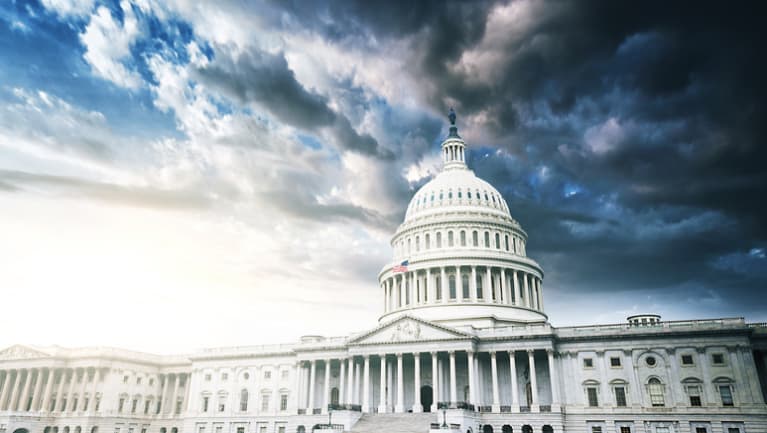
In a politically split Congress, the House will have more pull against the Senate on wages, leave, immigration and labor unions
Paid parental leave, a federal minimum wage hike and union-friendly laws are among the issues Democrats will work to advance on Capitol Hill after winning control of the House of Representatives following Tuesday's mid-term elections.
"You can absolutely anticipate more worker-friendly legislation," said Lisa Horn, vice president for congressional affairs at the Society for Human Resource Management (SHRM). "Of course, those would be hard to get enacted because they require the [Republican] president's signature, and if they're too progressive, Trump is unlikely to sign them."
More Oversight, Appropriations Battles
Controlling just the House is not that much different than if Democrats had taken control of both houses, Horn said. That's because they'll have the political heft to demand more oversight of workplace laws and policies, conduct investigations, and curtail Republican labor proposals through the appropriations process.
"Oversight efforts will really ramp up, and many employee-friendly proposals will certainly be pushed in the House," she said. "They'll likely be met with resistance in [the GOP-controlled] Senate, unless they could be modified to be less progressive or less employee-friendly."
For instance, Horn said, the Department of Labor (DOL) is scheduled to release its new overtime regulations in March. Those regulations are expected to raise the salary threshold for white-collar exemptions but not as high as the Obama administration had attempted. With Democrats controlling the House, they could try to stop the rule from being finalized through the appropriations process and oversight hearings, Horn said.
"Democrats might want to bring up the DOL secretary [to testify before Congress] and have him justify the rule," she said. And by controlling the House, the Democrats will have subpoena power should they wish to conduct investigations into President Donald Trump's or the GOP's policies.
SHRM has recommended that the DOL raise the salary threshold for exempt employees from $23,660 to nearly $32,000 annually. The Obama administration overtime rule, a regulation that the courts halted while the Trump administration developed its own overtime rule, would have doubled the salary threshold. SHRM opposed this doubling as "too much, too fast."
Paid Leave Laws
With the addition of many women and minorities to House seats following Tuesday's election, and given the likelihood that Rep. Nancy Pelosi, D-Calif., will return as House Speaker, Democrats are likely to champion policies that promote gender pay equity, diversity and workplace flexibility.
They may resurrect the Family and Medical Insurance Leave (FAMILY) Act, a national paid-leave program that would let workers receive a portion of their pay when they need time away from their jobs for family or medical reasons. Right now, federal law offers eligible workers up to 12 weeks of unpaid leave for such purposes.
Although only a handful of states offer paid family leave, others are expected to follow.
Also likely to resurface is the Healthy Families Act, which would require employers with 15 or more workers to provide up to seven job-protected paid sick days each year that employees could use to recover from their own illnesses, access preventive care, provide care to a sick family member, or attend school meetings related to a child's health condition or disability.
While SHRM supports employers providing paid sick leave, "we tend to oppose a mandated approach," Horn said. SHRM hasn't taken a position on the FAMILY Act. "We're still talking to [SHRM] members about what national, paid family leave might look like. Some elements raise challenges, like how it would interact with state laws, or how it would interact with employers who already offer paid family leave."
SHRM supports the Workflex in the 21st Century Act, under which employers would voluntarily offer full- and part-time employees a guaranteed minimum level of paid leave, plus flexible work options such as telecommuting.
Federal Minimum Wage
The federal minimum wage stands at $7.25 an hour—a rate that hasn't changed since July 2009. Several states have raised their own minimum wages.
Horn said she expects that, with Democrats in control of the House, raising the minimum wage will "certainly be on the table."
SHRM does not take a position on the federal minimum wage.
Labor Unions
Democrats are also likely to pursue the Workplace Democracy Act, versions of which have been re-introduced in Congress from 1992 to 2018. Provisions in various forms of this proposal might:
- Make it easier for workers to support unions through a majority sign-up process by allowing the National Labor Relations Board (NLRB) to certify a union as an exclusive bargaining representative if a majority of eligible workers sign valid authorization cards and the NLRB verifies that majority.
- Require an employer to begin negotiating within 10 days of receiving a labor-organizing petition.
- Breach attorney-client privileges and require employers to disclose money paid to anti-union consulting firms.
SHRM opposes these ideas.
Workplace Immigration
Democrats are likely to conduct more oversight of the administration's immigration agenda, while Republicans are likely to double down on their regulatory agenda, according to SHRM's Government Affairs staff.
Horn said the Trump administration is expected to propose regulations that could make it more difficult to hire foreign nationals on H-1Bs visas, and Democrats will no doubt push back.
She said SHRM will continue to advocate for H-1Bs "to access needed talent."
Even though stalemates are to be expected with Democrats in charge of the House and Republicans in charge of the Senate and White House, both parties may wish to cater to voters as the 2020 presidential election approaches by negotiating to resolve some workplace issues.
"It can't be a 'do nothing' Congress," Horn said.
***** ***** ***** ***** *****
Source: Society for Human Resource Management (SHRM)
https://bit.ly/2OyxfId
